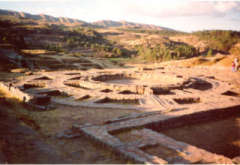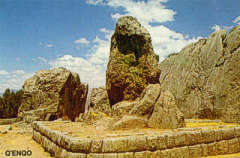|
The
Saqsaywaman archaeological complex has an area of 3,000
hectares and is located North of Cusco and is controlled
by the National Cultural Institute. It includes the following
archaeological monuments:
|
SAQSAYWAMAN.-
Located 2km from the city. Together with the city
of Cusco, this monumental complex is considered
the first of the new seven wonders of the world.
This huge construction was planned and built by
Andean Man. The Incas called it the House of the
Sun and the Spaniards called it a fortress because
of its zig-zag shape and the 1536 revolution.
The construction, which is made up of three platforms
one on top of the other, was one of the most important
religious complexes of its time.

Q'ENQO.-
The name means labyrinth or zigzag. Located
3km from Cusco, this temple dedicated to Mother
Earth is a unique center of worship and for ceremonies.
It has numerous ceremonial carvings, holes and
canals cut into the rock. One of its features
is a semi-natural underground chamber. |

The mixed-blood historian
Garcilaso Vega described in his book "The
Royal Commentaries" every detail of this
sacred spot, its walls, rooms, towers, doors and
canals, which have sparked great interest and
admiration from visitors and residents alike.
The enormous boulders that form part of the construction
were put together perfectly without using mortar.
The heaviest weighs up to 125 tons. Archaeologists
are currently excavating and have discovered water
fountains, canals and rooms. In a nearby flat
area, every June 24 local inhabitants hold the
Festival of the Sun, or Ind Raymi. Saqsaywaman
witnessed important historic events.

|
PUCA PUCARA.-
This construction is located 6km from Cusco. "Puca"
in Quechua means "Red" and "Pucara"
means "Fortress-Watchtower. Located at a strategic
point along the road to the Antisuyo (the jungle part
of the Inca empire), it also served as a checkpoint
on the Inca road and was a military and administrative
center.
TAMBOMACHAY.-
Located 7km from Cusco at 3,700 meters above sea level,
this site was popularly known as the "Inca's Baths".
Researchers believe Tambomachay was an important center
of worship of water. It is an archaeological complex
made up of well-crafted canals, walls and windows which
show the Incas' extraordinary architectural talents
and their in-depth knowledge of hydraulics.
LAQO, LANLAKUYOQ AND
KUSILLUCHAYOQ.-
These pre-Columbian observatories have felines, serpents
and birds carved into the rock and were ceremonial centers
of worship. These observatories have to be visited by
on foot.
The Saqsaywaman archaeological complex also boasts a
singularly beautiful landscape and abundant flora and
fauna. This includes llama, kestrels and falcons ("Wuaman"
in Quechua).
Continuing along
the route we come to Pisaq.

Click the image to enlarge it
|
